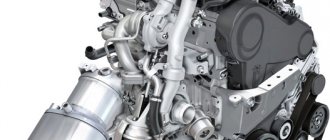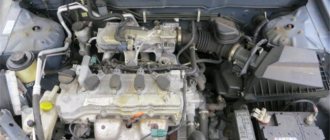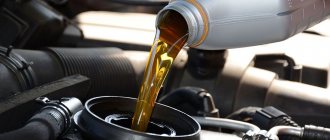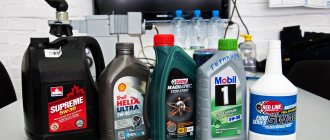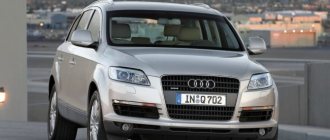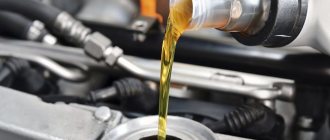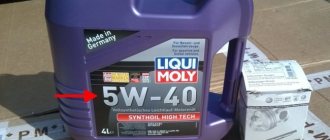Not too much reverence for numbers is clearly evident among the creators of Audi premium cars, who settled together with the entire research and production base in the Bavarian town of Ingolstadt. The Audi Q series of cars developed in waves, and, as usual, the first by number (Q3) was by no means the first to become the property of wealthy buyers. The premiere of the SUV dates back to 2011 (Shanghai).
One of the very first "threes"
Model history
The concept car of this version of the Cross coupe Quattro crossover was demonstrated four years earlier, in 2007. Of all the Q series crossovers, this car has had the opportunity to travel around the world more than others. Its assembly is carried out in Germany (Ingolstadt), Spain (Martorell), Brazil (Curitiba), China (Foshan), Russia (Kaluga). This speaks to the global economic thinking of Audi AG managers - not to spend money on transporting finished cars to South America and Asia, but to assemble ultra-popular family cars for recreation on the spot.
Auto giant for assembling VW/Audi cars in Foshan, China
The new platform is a symbiosis of the PQ35 “Golf” and PQ46, designed for more massive crossovers. The combination turned out to be very successful, as it allowed the engineers to achieve the ideal weight distribution of the car - 58:42. Metal balance:
- aluminum – hood and door No. 5;
- various grades of stainless steel - the “skeleton” of the body.
Functional diagram of Audi drive select technology
The front suspension is independent (McPherson), the rear is multi-link. The steering rack is equipped with an electric power steering with various settings. Brake system:
- front – ventilated disc;
- rear – non-ventilated disc;
- electronics – ABS, EBD, BA.
Optionally, the Q3 is equipped with a four-mode Audi drive select system (Comfort, Dynamic, Auto, Efficiency). With its help, the joint operation of adaptive shock absorbers, steering column, transmission and engine is controlled.
The first series of Audi Q3 (2011-2018) was restyled twice, in 2014 and 2016: manufacturers tried to modernize the internal contents of the car as much as possible, and above all, the transmission (refinement of the drive and chassis) and power plant (replacement of old engines 2 ,0 TFSI and TDI to new, more economical ones). The first generation includes both all-wheel drive and front-wheel drive versions.
The overall dimensions of the Q3 are a perfect reflection of the compactness of an SUV:
- length – 4388 mm;
- width – 1831 mm (with extended side mirrors – 2019 mm);
- height – 1608 mm;
- wheelbase – 2603 mm;
- ground clearance - 170 mm.
The trunk easily increases in volume by more than three times
The volume of the cargo compartment opened by the owner for the first time is 460 liters. By simply manipulating the rear seats, the spatial volume for stowing luggage increases to 1365 liters. The only “minus” is the lack of a voluminous, flat area: under the raised floor there is a niche for storing tools, rolling stock and small cargo.
Q3 second generation: minimum changes, maximum comfort
On July 25, 2021, the first spectators saw the second generation Audi Q3. The car is designed on the MQB platform. The contours, exterior, and filling of the engine compartment indicate that the creators made a clear focus on speed and comfortable travel conditions. In addition to the basic version of the car, powerful sports cars SQ3 and RS Q3 are entering the market.
Quattro all-wheel drive on Audi cars
The main distinctive features are a modernized massive radiator grille with a large number of vertical pillars; impressively sized air intakes built into the bumper design; system for partial or complete disabling of directional stability; option to turn off two of the four cylinders while driving to save fuel. The gearbox for front-wheel drive cars of the second generation is a six-speed preselective “robot”, for all-wheel drive cars – a seven-speed robotic S-tronic with a Haldex clutch.
And here without sports - nowhere
In the summer of 2021, the bosses of Audi AG, pleased with how the presentation of the second generation of the SUV went a year earlier, prepared another gift for car enthusiasts. For those who unconditionally accepted the Q3, but wanted even more speed, dynamics and energy in motion, the car received a new Sportback body. The most recognizable crossover on European autobahns is the 40 TFSI Quattro.
2021 Audi Q3 Sportback
The suspension and steering are undoubtedly places where there are still many “blank spots”, that is, opportunities for reducing the excessive ride stiffness noted by almost all testers, and reducing the weight distribution of the steering. The MQB platform, tested in the second generation Q3, is exhibited with new versions of turbocharged engines, a 7-speed S tronic robotic gearbox, and quattro all-wheel drive with a multi-plate friction clutch.
The gearbox and engine in this Sportback configuration are close to ideal:
- no hesitations at the start, like diesel Q8s (only the e-tron electric car starts better);
- excellent environmental performance, despite the very stringent requirements of the Euro VI protocol.
The Sportback doesn't look like a spaceship at all
The two-liter turbocharged DKTC engine accelerates to “hundreds” in 7.9-8.0 seconds. With proper running-in, this figure can easily be brought closer to the passport 7.4 s. In general, you can say about the car in one phrase: “Maximum convenience with a minimum of electronics.” Not overloaded with all sorts of technological gadgets, the interior looks comfortable and spacious.
Engines for Audi Q3
As the junior model in the Q crossover line, the “troika” has not yet received a single engine with a volume of more than two liters. This is not surprising, first of all, because the definition of the car’s base includes the word “compact”. Engines with a volume of more than three liters under the hood of the Q3 are simply a waste of money. This is an SUV, after all, and not a full-size all-terrain vehicle... Although, a certain amount of conservatism, as in all other crossover developments by VW/Audi AG motorists, is present: there is not a single engine in the line without a turbocharger, be it a diesel engine or a gasoline engine.
| Marking | Type | Volume, cm3 | Maximum power, kW/hp | Peculiarities |
| Q3 | ||||
| CHPB | petrol turbocharged | 1395 | 110/150 | direct injection |
| CLLB | diesel turbocharged | 1968 | 130/177 | Common Rail |
| CCZC | petrol turbocharged | 1984 | 125/170 | direct injection |
| CPSA | —:— | 1984 | 155/211 | direct injection |
| CZEA, CZDA | —:— | 1395 | 110/150 | DOHC, direct injection |
| CUWA | diesel turbocharged | 1968 | 135/184 | direct injection |
| CULB | petrol turbocharged | 1984 | 132/180 | direct injection |
| CULC | —:— | 1984 | 162/220 | direct injection |
| DKTC | —:— | 1984 | 132/180 | direct injection |
| Q3 Sportback | ||||
| DADA | petrol turbocharged | 1498 | 96/130, 110/150 | DOHC |
| DFGA | diesel turbocharged | 1968 | 110/150 | DOHC, Common Rail, intercooler |
| DKTA | petrol turbocharged | 1984 | 169/230 | direct injection |
| CZEA, CZDA | -:— | 1395 | 110/150 | direct injection |
| DKTC | —:— | 1984 | 132/180 | direct injection |
The 1.4-liter baby TFSI with the factory code CZDA (CZEA) turned out to be so successful that it was included in the list of engines for the sports version of the Q3 Sportback. Another unconditional “master” of the engine compartments of all modern Q3 trim levels is the two-liter DKTC internal combustion engine.
How much oil to fill in the Audi Q3 engine
First generation 8U, 2011-2019
The 1st generation Audi Q3 is based on the PQ35 platform, combined with a stretched PQ46 platform. Thus, related models of this crossover are the Volkswagen Golf and Passat, as well as the Skoda Superb. The combination of both “carts” made it possible to achieve an optimal center-to-axle weight distribution of 58:42 with minimal production costs. The car received the branded Quattro all-wheel drive as an option, as well as the 4th generation Haldex clutch (after 2015 - already the 5th generation). This clutch ensured the distribution of torque between the wheels in a ratio of 50 to 50. Gearboxes were a six-speed manual or a 7-speed “robot”. The basic version of the Q3 was equipped with a 1.4-liter turbo engine with a power of 150 hp. With. In 2014, restyling took place. The updated car received an improved 1.4 turbo with a half-cylinder deactivation system. A more powerful EA888 gen 3 unit with a volume of 2.0 l (180-220 hp) was also available. The “charged” version of the RS Q3 had a 360-horsepower 2.5-liter engine under the hood.
Also read: Engine oil for Peugeot 4007 engine
Gasoline engines 2011-2019
- 1.4 150 l. With. (CHPB), oil volume - 4 liters, tolerance and viscosity: API-SM, SN; SAE 5W-40, 5W-30, 10W-40, 10W-30, 0W-40, 0W-30
- 2.0 170 l. With. (CCZC), oil volume - 5 liters, tolerance and viscosity: API-SM, SN; SAE 5W-40, 5W-30, 10W-40, 10W-30, 0W-40, 0W-30
- 2.0 180 l. With. (CULB), oil volume - 5.7 liters, tolerance and viscosity: API-SM, SN; SAE 5W-40, 5W-30, 10W-40, 10W-30, 0W-40, 0W-30
- 2.0 211 l. With. (CPSA), oil volume - 4.6 liters, tolerance and viscosity: API-SM, SN; SAE 5W-40, 5W-30, 10W-40, 10W-30, 0W-40, 0W-30
- 2.0 220 l. With. (CULC), oil volume - 5 liters, tolerance and viscosity: API-SM, SN; SAE 5W-40, 5W-30, 10W-40, 10W-30, 0W-40, 0W-30
Diesel engines 2011-2019
- 2.0 177 l. With. (CLLB), oil volume - 5 liters, tolerance and viscosity: API-CI-4, CJ, CJ-4; SAE 5W-40, 5W-30, 10W-40, 10W-30, 0W-40, 0W-30
- 2.0 184 l. With. (CUWA), oil volume - 4 liters, tolerance and viscosity: API-CI-4, CJ, CJ-4; SAE 5W-40, 5W-30, 10W-40, 10W-30, 0W-40, 0W-30
Second generation F3, from 2018
The 2nd generation Audi Ku-3 is noticeably different from its predecessor. Changes are visible in the design concept, interior design and technical terms. Characteristic features of the new model's exterior include an octagonal grille, sculpted side doors, massive wheel arches and narrowed wedge-shaped headlights, which are available in three modifications. All headlights are LED, but the top version features high-tech Matrix LED optics with adaptive high-beam lighting. The crossover is based on the MQB platform. It has increased in size and become more spacious, and the trunk volume has increased to 420 liters (previously it was 530 liters). Engines for the Russian market are gasoline 1.4 and 2.0 (150-180 hp), working with a robotic gearbox.
Also read: Motor oil for Suzuki Vitara engine
Gasoline engines from 2018
1.4 150 l. With. (CZDA, CZEA), oil volume - 3.8 liters, tolerance and viscosity: API-SN; SAE 5W-40, 5W-30, 10W-40, 10W-30, 0W-40, 0W-30
The most popular engine for the Audi Q3 and Q3 Sportback
Of course, having touched on this topic in the paragraph above, it would be strange not to talk about the CZDA engine (EA211 line), since it successfully “mastered” both versions of the Q3 SUV. The production of this version has been launched since 2014 at the engine plant in Mlada Boleslav (Czech Republic). The power of the 1395 cm3 engine is 150 hp. The IHI RHF3 turbine is responsible for the forced mode. The compression ratio is 10.0:1. Environmental protocol – Euro VI. CO2 emissions range from 116-156 g/km. The installation is equipped with a rich set of modern technologies:
- valve drive from two Double Over Head Camshafts (DOHC);
- hydraulic compensators;
- the presence of valve timing regulators on the intake and exhaust manifolds;
- all-aluminum BC and cylinder head.
“Lightweight” development of the Volkswagen Group – CZDA engine
The engine has a simple design and a very reliable timing belt. The belt requires replacement after 100 thousand km. mileage The engine lacks a VW “trick” of the second decade of the 21st century – a system for shutting off two cylinders while driving. “Twin brother” CZEA has the ability to remove two cylinders from the circuit at low speeds. For example, in stop mode with the air conditioning on, this option allows you to significantly save fuel.
Turbocharger IHI RHF3
The volume of 5W-30 oil filling is 3.8 liters. It is this technological operation that requires the closest attention of car enthusiasts. Due to the ring sticking effect, oil consumption may increase noticeably during operation. The turbine requires very close attention: if you do not notice the actuator thrust wedge in time, its breakdown is only a matter of time. The rather complex mechanism of action of a two-thermostat pump can lead to leakage over time.
Fuel consumption: in the city - 8.3 l, outside the city - 5.4 l, combined - 6.5 l. The service life of the CZDA engine is 250 thousand km.
Reliability, shortcomings and repair costs of the Audi Q3
Suspension
Despite the hefty cost of small suspension replacements, the main “surprises” can await the owner after 200 thousand kilometers. First of all, the power steering pump, which will require replacement, and the rack and pinion steering mechanism. The components simply wear out, and replacing them is really expensive. It won't seem enough.
Electrics
A lot of negativity is associated with failures of on-board electronics. Chaotically triggered sensors and warning lights are not inspiring. But a particularly unkind word is given to the start/stop system - a failure of the ignition system when a car, moving in a traffic jam, turns off the engine when stopping, and then refuses to start it.
Engine
Diesels also have their problems. Among the first are problems with pump injectors, which sometimes cost up to €300. In addition, if the engine overheats, the cylinder head cracks, which alone (without work and the cost of other spare parts) will cost 36,000 rubles. Particulate filters can also cause trouble.
Body
Rumor unfairly lists problems with door handles as body problems. Keyless entry is denied. But this is again electronics. But the large cells of the radiator grille, which allow road stones to pass through to it, are a complaint to the address. In order not to buy a new radiator, it is better to install a mesh.
Transmission
No curses were noted against the transmission.
However, over significant runs, it will make itself known with leaking seals. It is better to change them immediately. Also, the owner of a used car may experience wear on the hydraulic control unit, a symptom of which is a missing reverse gear (for 4x4 versions). Technical data
| Body type | station wagon | |
| Dimensions, length x width x height, mm | 4385/1831/1608 | |
| Wheelbase, mm | 2603 | |
| type of drive | full | |
| Trunk volume, l | 460/1365 | |
| Fuel tank volume, l | 64 | |
| Curb/gross weight, kg | 1640/2165 | 1660/2165 |
| Transmission | 7-st. auto | 7-st. auto |
| engine's type | petrol, L4 | diesel, L4 |
| Working volume, cm3 | 1984 | 1968 |
| Maximum power, hp (rpm) | 211 (6200) | 177 (4200) |
| Maximum torque, Nm (rpm) | 300 (4900) | 380 (2500) |
| Maximum speed, km/h | 230 | 212 |
| Acceleration 0-100 km/h, s | 6,9 | 8,2 |
| Fuel consumption, highway/city, l/100 km | 6,4/10,2 | 5,3/7,0 |
pros
- dynamics
- controllability
- driving pleasure
- prestige
- diesel engines
- body
- suspension

